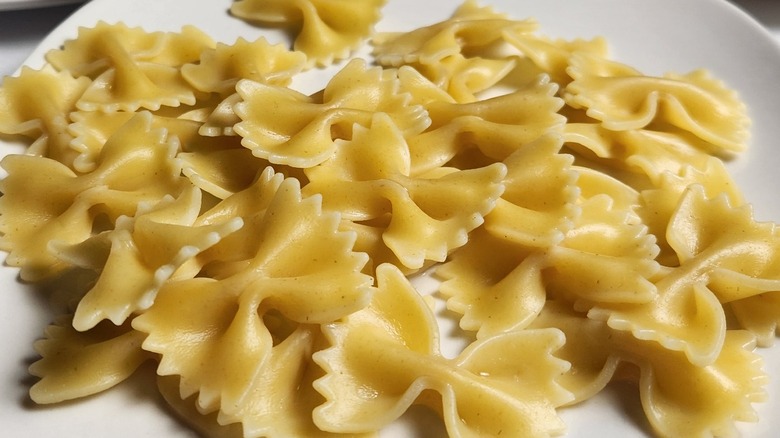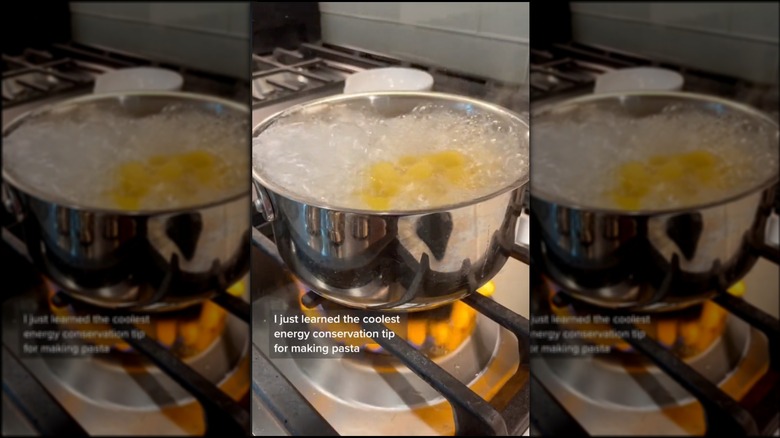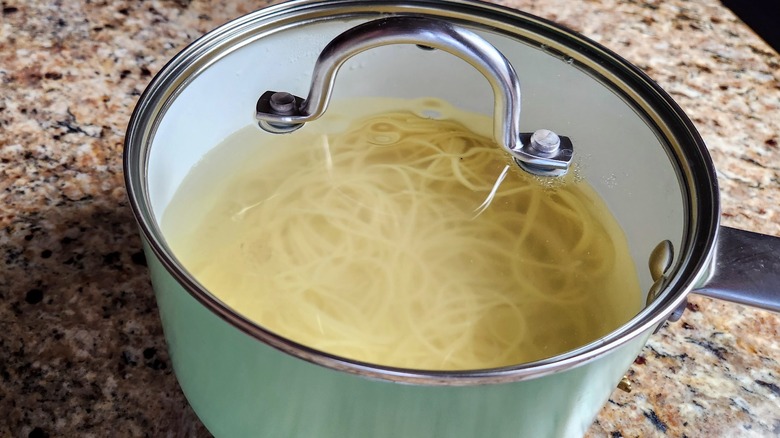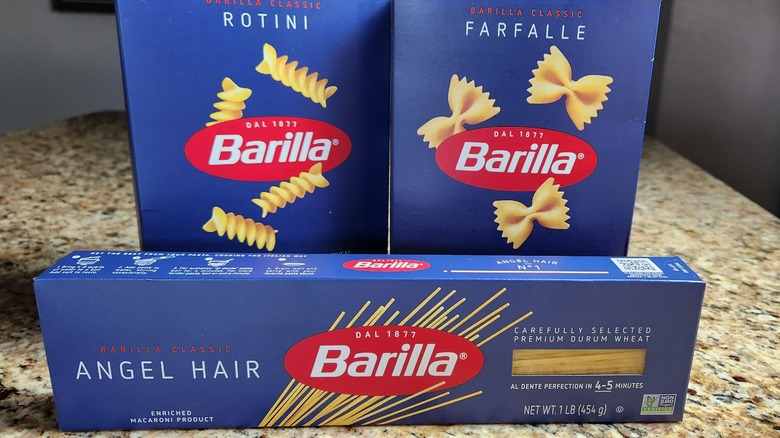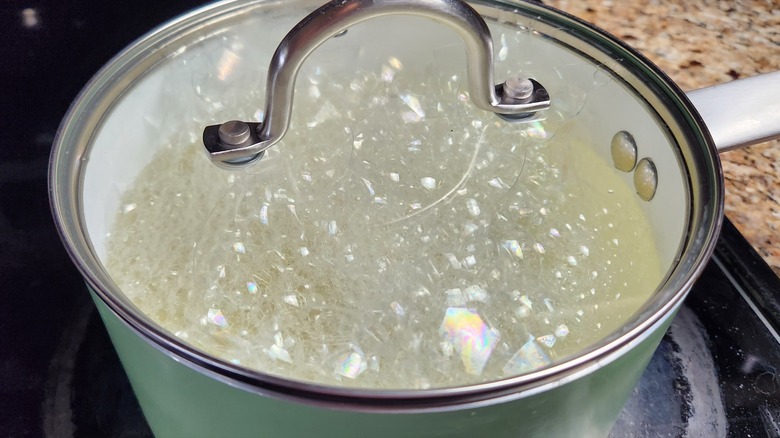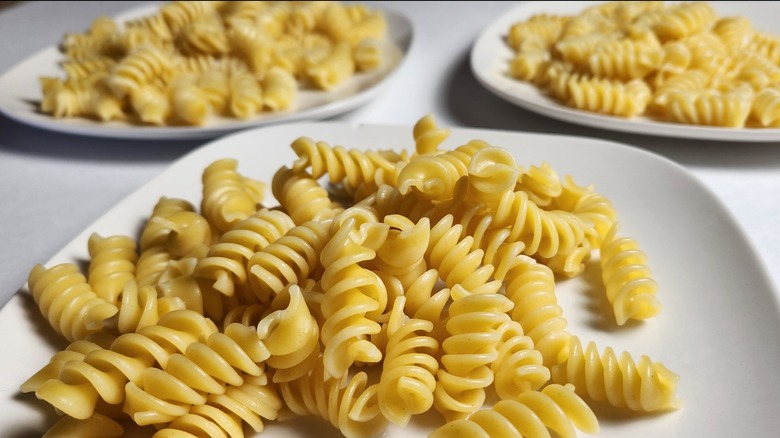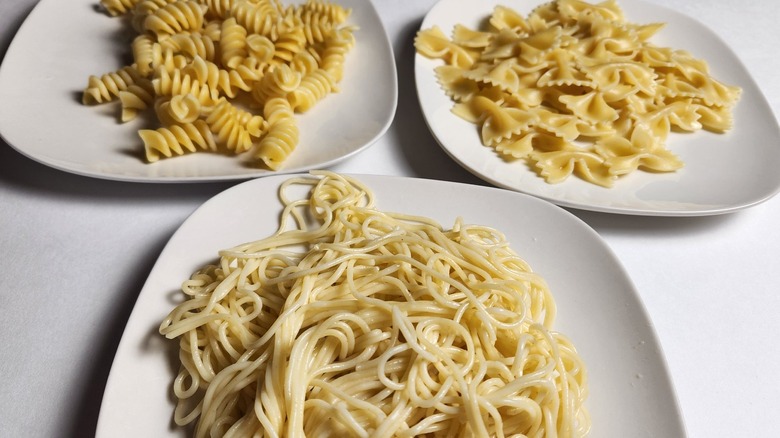Does TikTok's Energy Conservation Hack For Cooking Pasta Really Work?
TikTokers have a habit of offering viewers new ways to do common cooking tasks. So, when we found a hack promising to revolutionize our pasta-cooking game while saving energy, we couldn't pass up the opportunity to give it a try. Supposedly, you only need to boil your noodles for two minutes to produce pasta with a perfect texture. At least, that's the claim if you want to save on your energy bill or it's just hot outside and you don't want to have your stovetop turned on any longer than you absolutely have to. It seems too good to be true. So we set out to discover whether the method actually works.
With different pasta shapes having different cooking times and stovetops being a little different depending on whether they're gas or electric, we took our experiment a little further and introduced a few variables. We also looked into the science behind why this cooking method might work if done properly. So, does the TikTok pasta hack live up to its hype, or will you find yourself going back to the printed box directions in the future? We've done all the hard work so you don't have to. So, let's find out whether it's possible to boil pasta for just two minutes to save energy.
TikTok's pasta energy conservation hack
TikToker @ambitiouskitchen revealed a way to cook pasta and save energy at the same time. She tossed her pasta into boiling water on a gas stove and continued to let it boil over the flame for two minutes. However, there was a trick to her method. After the two minutes were up, she turned off the heat, covered the pot with a lid, and let the pasta sit in the hot water on the stovetop for an additional 10 minutes. She swore that "your pasta will be perfectly cooked every single time" using this method. While it certainly doesn't save time, it does save energy. But will the pasta be perfectly cooked? We were dubious.
When someone posted a question asking the TikToker about the pasta shape, she said it's best to test the noodles for doneness after a few minutes while they're still sitting with the lid on and the heat off. So, the 10 minutes isn't as firm of a time as she initially makes it out to be. Not being sold on the idea of the technique being foolproof, we thought we'd get to the bottom of this hack and its permutations.
The science of carryover cooking
The TikTok energy conservation pasta hack relies on carryover cooking, which may be familiar from cooking steaks. It's why you let a steak rest on a plate after its official cooking time so you'll end up with the perfect doneness. However, steaks are not the only types of food that can benefit from carryover cooking. The same principles work with other types of food as well. However, it might take some experimentation to get the results you want.
Part of what happens in carryover cooking is that hot items continue to share heat until everything reaches an equilibrium, with heat flowing from hotter items (in this case, the boiling water) to cooler items (the pasta). In fact, the greater the temperature difference between the water and the pasta, the faster the heat will transfer to the pasta.
A few other things affect carryover cooking, such as the capacity the pasta has to retain heat, the shape of the pasta, and how hot the water is in the first place. A bigger piece of pasta has more heat capacity (thermal mass), so it has more heat inside it when you stop adding external heat. A piece of pasta with the least surface area will retain more heat during carryover cooking. Thus, the ideal pasta shape for carryover cooking would be spherical. The water temperature is important, too. So, the hotter the water stays after turning off the heat, the more carryover cooking will take place.
Does the pasta shape matter?
It doesn't seem possible for this hack to work the same for every pasta shape. After all, different shapes have different cooking times. Thus, we are testing three different pasta shapes with different cooking times. The types we chose range from four to 11 minutes of suggested cooking time. Angel hair pasta only needs to be boiled for a minimal amount of time –- just four minutes. Rotini has a medium-length boiling requirement of seven minutes. Meanwhile, farfalle pasta has the longest cooking time of 11 minutes.
We were worried that carryover cooking might overcook the angel hair pasta since it only needed 4 minutes of boiling but would get a total of 12 minutes in the water. While it wasn't al dente with the TikTok method, it was still within a normal textural range. So, if you don't like your pasta al dente, it was just about perfect. The rotini, which normally has a seven-minute cooking time, ended up al dente with the TikTok method. The farfalle normally has an 11-minute cooking time, so the TikTok method didn't work as well. It was so undercooked that it was doughy and stuck to our teeth when we ate it.
Overall, with the TikTok method, the rotini turned out perfectly al dente, the angel hair pasta was cooked beyond al dente but within a normal range, and the farfalle was far undercooked and sticky. So, the pasta shape definitely matters.
Does it matter if you keep the pot on the burner on an electric stove?
In the TikTok video, user @ambitiouskitchen uses a gas stove, which means that turning it off removes external heat from most of the pasta pot. Thus, in our initial experiment, we removed the pot from our electric stovetop. We experienced very different results when keeping the pot on the stovetop.
When we left the pot on the electric stovetop after turning off the heat, the water continued boiling the whole 10 minutes. It acted as if we'd never turned off the heat in the first place. It started out at a rolling boil, but it switched to a lower boil during the last couple of minutes. Since the water continued to boil, it was equivalent to keeping the heat on the entire time.
The angel hair pasta only needed a four-minute cooking time, according to the box. So, allowing it to stay on the stovetop for 10 minutes caused it to overcook immensely. It wasn't mushy, but it was on its way there. When we left the rotini on the burner with the lid on, it cooked perfectly for someone who wants their pasta cooked just beyond al dente. We got similar results for the farfalle. It was still al dente but slightly softer than cooking according to the box directions. So, leaving the pot on the burner seems to only work for pasta that has a seven-minute or more cooking time.
How does it compare to pasta cooked according to the box instructions?
We followed the box instructions for making al dente pasta to do our comparisons. To follow the TikTok hack completely, we didn't add any salt to the water in our experiments that used the TikTok method. However, since the box instructions say to add salt, we did so when cooking our control pasta.
In the case of angel hair pasta, which only had a four-minute cooking time, the pasta made with the TikTok method was significantly softer than the al dente pasta we cooked from the box directions. However, it wasn't immensely overcooked as we had feared. The TikTok method produced slightly softer al dente pasta than the box method for rotini. So, it yielded the closest results. However, the farfelle was sticky and undercooked and didn't reach al dente stage. So, it was the furthest in texture from the box-instructions method. The only one that had the same texture with the TikTok method as with the box instructions was the rotini, which would normally cook for seven minutes.
Our verdict
TikTok's energy conservation "hack" for pasta is flawed. It seems great initially, but all the different shapes and sizes mean that two minutes of boiling time and 10 minutes sitting off the heat with the lid on doesn't leave your pasta "perfectly cooked every time," as the TikToker says. Some shapes work better than others. Shapes with seven-minute cooking times seem to turn out closer to the right texture using the TikTok cooking method.
While the TikTok method worked passably, we want to offer a slightly different version that works better if you have an electric non-convection cooktop. To still conserve energy while cooking your pasta perfectly, simply boil the pasta for two minutes, turn off the heat, add a lid, and let the pot sit on the still-hot stovetop for the remainder of the cooking time listed on the box. Since the stovetop is still passing heat to the pot and the lid is on the pot, the water will continue boiling while conserving energy.
If you're going to try the TikTok pasta-cooking method, we think it's best to stick with pasta varieties with mid-range cooking times when seeking the best results. While you could continually check the texture for other pasta shapes to ensure they're not over- or undercooked, you'll lose heat every time you remove the lid. So, the best option for energy conservation is to boil it for two minutes and keep it on the stovetop while you wait the extra 10 minutes.
